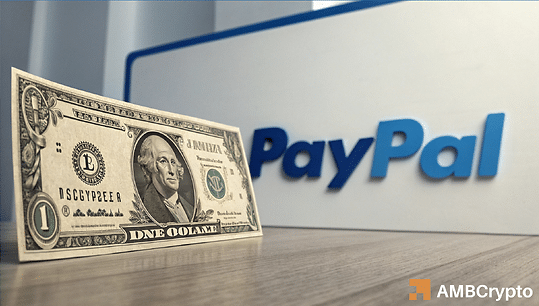During the latter part of 2024, PayPal USD created a buzz in the market due to various reasons. This marked the first attempt by a traditional payment provider to enter the world of Web3 on a large scale, signifying a new era for digital assets.
Although there were high expectations for PayPal USD, its journey so far has shown signs of a slowdown in the narrative surrounding digital assets. The initial enthusiasm following its launch on the Solana network has waned over time.
Initially reaching a market capitalization peak of $1.01 billion on August 25th, PayPal USD has been experiencing a gradual decline, dropping below $500 million by December, with the current market capitalization standing at $515.17 million.
The decline in the market capitalization of PayPal USD coincided with a decrease in its dominance on the Solana network.
Initially, PayPal USD’s market dominance on Solana outperformed Ethereum, reaching a peak of 65.79% on August 29th. However, this dominance dropped to 25.42% by November 27th.
The performance of the total PYUSD market capitalization mirrored the trend in Solana dominance, indicating a lack of sustained utility on the Solana network. Notably, Ethereum controlled 67.21% of the circulating supply of PayPal USD at the time of writing.
The Factors Behind the Initial Growth of PayPal USD Market Capitalization and the Current Scenario
The decline in the PYUSD market capitalization coincided with increased demand in the cryptocurrency market. Prior to this, there was a rally from June 26th to August 30th, 2024, just before the market frenzy. During this time, there were more stablecoin holders, and the PayPal stablecoin offered attractive yields on the Solana network.
However, with the market turning highly bullish, liquidity providers may have withdrawn their assets and redirected them into cryptocurrencies. Additionally, being relatively new, PayPal USD had not established sustainable transaction volumes.
While this reasoning may explain the decrease in liquidity for the PayPal-related stablecoin, it should be viewed as speculative. Notably, the stablecoin continues to show significant on-chain activity, with an increase in circulating supply on both networks over the last 30 days.
For instance, there was a 5.31% increase on Ethereum and a 4.12% increase on Solana in the past 4 weeks, indicating ongoing demand for the stablecoin. However, its usage remains limited to these two networks, serving as a barrier to broader adoption.

